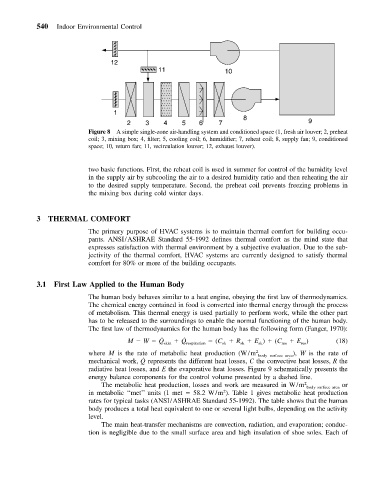Page 551 - Mechanical Engineers' Handbook (Volume 4)
P. 551
540 Indoor Environmental Control
12
11 10
• • • •
• • • • •
• • • •
• • • • •
• • • •
• • • • •
• • • •
• • • • •
• • • •
• • • • •
• • • •
1 • • • • • • • • •
• • • • •
8
2 3 4 5 6 7 9
Figure 8 A simple single-zone air-handling system and conditioned space (1, fresh air louver; 2, preheat
coil; 3, mixing box; 4, filter; 5, cooling coil; 6, humidifier; 7, reheat coil; 8, supply fan; 9, conditioned
space; 10, return fan; 11, recirculation louver; 12, exhaust louver).
two basic functions. First, the reheat coil is used in summer for control of the humidity level
in the supply air by subcooling the air to a desired humidity ratio and then reheating the air
to the desired supply temperature. Second, the preheat coil prevents freezing problems in
the mixing box during cold winter days.
3 THERMAL COMFORT
The primary purpose of HVAC systems is to maintain thermal comfort for building occu-
pants. ANSI/ASHRAE Standard 55-1992 defines thermal comfort as the mind state that
expresses satisfaction with thermal environment by a subjective evaluation. Due to the sub-
jectivity of the thermal comfort, HVAC systems are currently designed to satisfy thermal
comfort for 80% or more of the building occupants.
3.1 First Law Applied to the Human Body
The human body behaves similar to a heat engine, obeying the first law of thermodynamics.
The chemical energy contained in food is converted into thermal energy through the process
of metabolism. This thermal energy is used partially to perform work, while the other part
has to be released to the surroundings to enable the normal functioning of the human body.
The first law of thermodynamics for the human body has the following form (Fanger, 1970):
˙
˙
M W Q skin Q respiration (C R E ) (C res E ) (18)
sk
sk
sk
res
2
where M is the rate of metabolic heat production (W/m body surface area ), W is the rate of
˙
mechanical work, Q represents the different heat losses, C the convective heat losses, R the
radiative heat losses, and E the evaporative heat losses. Figure 9 schematically presents the
energy balance components for the control volume presented by a dashed line.
The metabolic heat production, losses and work are measured in W/m 2 body surface area or
2
in metabolic ‘‘met’’ units (1 met 58.2 W/m ). Table 1 gives metabolic heat production
rates for typical tasks (ANSI/ASHRAE Standard 55-1992). The table shows that the human
body produces a total heat equivalent to one or several light bulbs, depending on the activity
level.
The main heat-transfer mechanisms are convection, radiation, and evaporation; conduc-
tion is negligible due to the small surface area and high insulation of shoe soles. Each of

